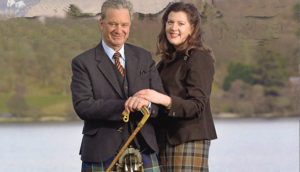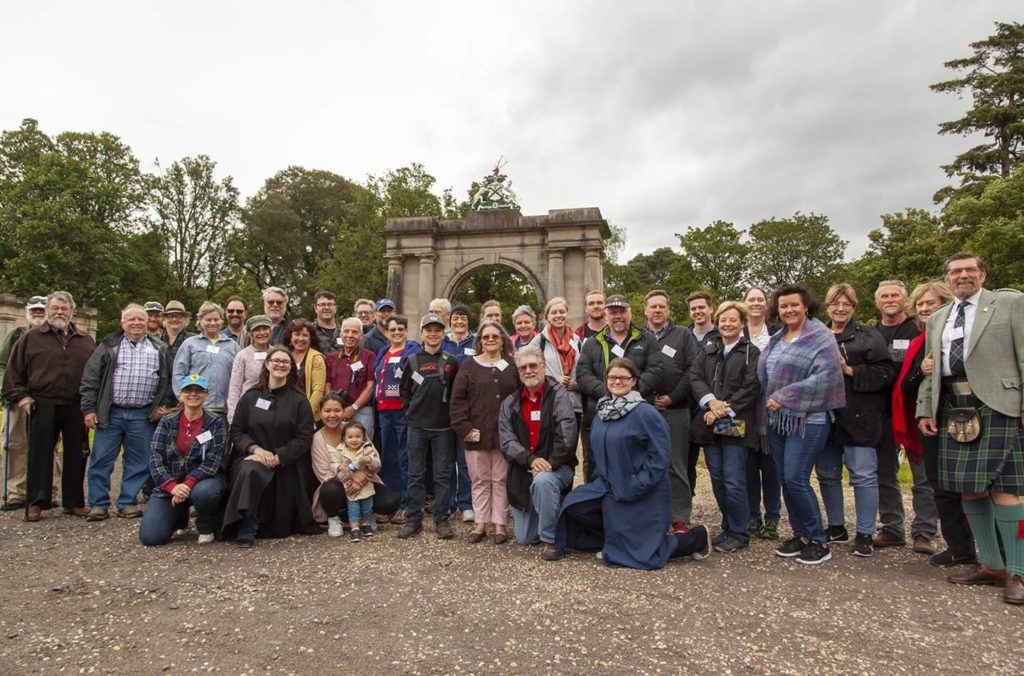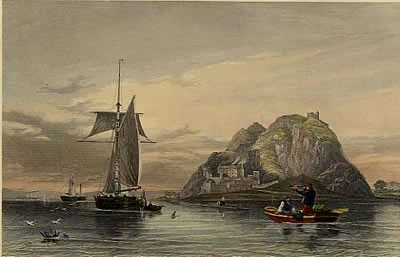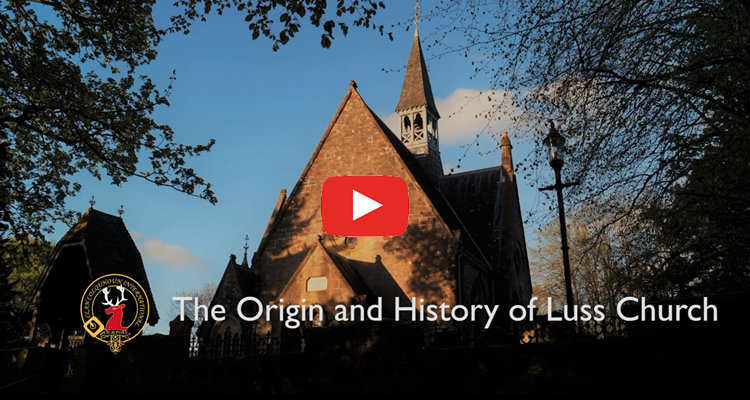Clan Colquhoun
The lands in the Loch Lomond area of Scotland have been held within the Colquhoun family since 1150 AD, when the lands were granted to the Laird of Luss. The Colquhouns originated at Old Kilpatrick on the River Clyde, and through the marriage of Robert of Colquhoun to the daughter of the Laird of Luss in 1358, the Luss lands came into their hands.
The Colquhoun charters to the Barony of Colquhoun, which runs eastwards from Dumbarton for six miles towards Glasgow, granted around 1240 AD. Since those times, there has been a constant Colquhoun presence in the area.

Sir Malcolm and Lady Colquhoun of Luss
A look at the distribution of the clan around the world is an interesting study and one that really began at the turn of the 17th century. There are numerous forms of spelling of the name ‘Colquhoun’ mainly inscribed by those who were not familiar with the people of that area. Prior to the end of the 16th century, the Colquhouns and septs generally shared a common history in Scotland. There were those who became mercenary soldiers on the continent serving in Sweden and in France, but little migration.
It was in the early part of the 17th century that Scottish landowners began to acquire properties in Ireland following the’ flight of the earls’. They had ‘tenants’ who took the opportunity to have a piece of land to farm and they moved to Ireland to work the estates for their landlords. Over the next century, religious strife led to many who moved to Ireland to escape the persecution. At one stage the Scottish King James also sought to transport his troublesome clans into that land. In Ireland, the spelling of the name underwent changes as the uneducated put it together phonetically and it became ‘Colhoun, Cohoon, Cahoon and other variants.
Breaking new land was hard and many saw the opportunity to turn this to their own advantage in America rather than for a ‘landlord’ and the Ulster Scots migrations became common. There the name became ‘Calhoun’, probably a misreading of the ‘o’ for an ‘a’. Generally, those who went to America from Scotland retained the Colquhoun form with’quh’ in the name and this can be an indication of whether the family arrived direct from Scotland or via Irish settlements. (See the ‘Chronicles’; The Ulster Connection). Whilst there were occasions when the misspelling of the name occurred in Scotland and England, generally it retained its usual spelling.
America also served as a penal colony and received its share of ‘exiles’ arriving as bonded servants having to serve a fixed period before they were free to settle, such as William Cahoon who was a prisoner taken at Dunbar in 1650 and transported to America in 1651. In Canada the majority of the settlers arrived direct from Scotland and the American spelling is not so common in that part of North America. At the time of Independence, those who wished to remain British moved northwards to Canada, or returned home.
The traditional form of the name survived and later migration from Scotland sustained this spelling. In Australia the same general rule applies, with Scottish settlers retaining the original form. Whilst there will always be exceptions to this, generally, the way you spell your name can indicate your family’s pathway to the new country.
Names associated with Colquhoun with their possible connections. The main Clan names are in bold.
Cahoon Irish form of Colquhoun
Cahoone Irish form of Colquhoun
Cahoun Irish form of Colquhoun
Cahn variation of Colquhoun
Cahun variation of Colquhoun.
Calhoon American form of Colquhoun
Calhoun American form of Colquhoun
Caun corruption of Colquhoun
Cessoc associated with Kessog of Luss
Cohan corruption of Colquhoun
Colquhoun
Cothun corruption of Colquhoun
Cowan corruption of Colquhoun
Cowen corruption of Colquhoun
Cowing corruption of Colquhoun
Culchom corruption of Colquhoun
Culhane corruption of Colquhoun
Gahn Swedish form of Colquhoun
Gilmer variation of Gilmore
Gilmore associated with Luss
Gilmakessoc associated with Luss
Ingram accepted as descendants of Ingram de Colquhoun
Kahn variation of Colquhoun
Kessan variation of Kessog
Kessog name associated with Luss area
Kilpatrick
King
Kirkpatrick
Kirk
Lang descriptive name for a tall person found in many areas
Law common name in Glasgow area
Leckie a common name in Colquhoun lands in Dumbartonshire
Lennox name found in the Lennox district, long associated with Luss
Luss name associated with Luss area
MacA'Chambaich Gaelic form of Colquhoun
Macauslan strictly Buchanans but lived in Glen Douglas & intermarried Colquhouns
MacClintock Irish form of McLintock
MacCowan variation on Cowan
MacKessog associated with Luss parish
MacKinlay lived on Colquhoun lands
MacLinden variation on McLintock
McLintock
MacManus lived among and serve the Colquhoun families
MacMains variation of Mcmanus
McOwen variation of Cowan
MacWalter local family name in Luss parish
Pickens
Potter
Qulchone variation of Colquhoun
Smith an occupational name found in many areas
Smollett family associated with Dumbartonshire
Walker occupational name found in many areas
Please note, this list is not exclusive but covers the most common forms of the names.
Since the very earliest records that have come down to us, the deer-haunted hills and wooded glens and lochside lands of Luss have belonged to the ancestors of the present chief of the Clan, Sir Malcolm Colquhoun, 33rd of Luss.
His remote forefathers who lived here nearly eight hundred years ago were most likely a branch of the ancient rulers of the Lennox, and they used the surname of Luss, taken from the name of their lands. They were a sacred family, Celtic priests and hereditary guardians of the bachuil or crozier of St Kessog, the martyr who dwelt in Glen Luss or on Inchtavannach, the 'monk's isle' in Loch Lomond. So it is possible they were also related to the Saint himself, as was often the case with hereditary guardians of saintly relics in the old Celtic Church. Indeed, the place name 'Luss' itself is probably derived from an old word meaning the bounds of a sanctuary, for Robert Bruce confirmed by Royal Charter that all the grounds within a 'girth' of three miles around the church of Luss was a hoy place of refuge.
The present chief’s forebear Malduin of Luss was Dean of the Lennox in 1202, and three generations later his then ancestor, Sir Ian of Luss, appears on record as still guarding their family saint’s bachuil. The heiress of the ancient Celtic line was the Fair Maid of Luss. Who by 1368 had married Sir Robert Colquhoun of that Ilk, chief of a clan that had fought for King Robert Bruce in the War of Scottish Independence and whose strong castle of Dunglass lay some miles away to the south on the river Clyde at Colquhoun near Dunbarton.
The Fair Maid’s grandson John Colquhoun, 10th of Luss had to be called upon in 1411 by Duncan, Earl of the Lennox to implement his solemn contract and oath to marry the earl’s daughter, Lady Margaret. In 1424, when James 1 returned from his long captivity in England and destroyed the Lennox family whom he regarded as his personal enemies, this Colquhoun of Luss was chosen by the King for the key post of Governor of Dumbarton Castle, the royal fortress that dominated the Lennox. This was possibly the origin of the traditional story explaining the Colquhoun heraldic supporters of two deerhounds, together with their crest of a stag’s head and motto “Si Je Puis” (the coat of Arms, the black engraved saltire on a silver shield, is obviously derived from the saltire of the Earls of Lennox, itself probably related to the Arms of a groups of powerful Northumbrian families at the dawn of heraldry). The tale runs that the king asked the Colquhoun chief to recover Dumbarton Castle from his enemies; that Luss replied “si je puis” (If I Can), and then pursued a stag with hounds past the castle until the garrison joined in the chase, whereupon the clansmen rushed the castle and captured it for the king. This Sir John was later slain with 120 of his men by a band of marauding Western islesmen, led by the robber chief Lachlan Maclean of Duart, whilst making a gallant last stand on the Isle of Inchmurrin in Loch Lomond on 24 September 1439.
His son Malcolm having predeceased him, he was succeeded by his capable grandson, another Sir John Colquhoun, 11th of Luss. One of the greatest of his canny line, he had his lands erected into the free barony of Luss by King James II in 1457, with the right of “pit and gallows”, which meant a local jurisdiction including the powers of life and death (held by the Colquhoun chiefs until 1747). The Gallowshill across the main road from Rossdhu still marks the site of the Colquhoun “dule-tree”. Sir John, who was Comptroller of the Exchequer from 1465 to 1469, Great Chamberlain of Scotland and joint Ambassador to England, was the chief who built the old castle of Rossdhu (the “black headland”) that forms a peninsula in Loch Lomond, as well as the architecturally interesting private chapel of St Mary of Rossdhu, dedicated in 1469. This mediaeval chapel’s beautiful contemporary illuminated Book of Hours his to be found in among the public treasures of New Zealand, at the other end of the world – a place undreamt of by the holy man who wrote it. But Sir John’s younger son Robert Colquhoun, Bishop of Argyll, had previously been rector of St Kessogs Church in the village of Luss itself (the church of the family saint) and so his mediaeval tomb effigy is still to be seen there. Sir John was killed in 1478 by a cannon ball (no longer a military novelty) which also killed two other distinguished knightly lairds, whilst taking part in the siege of Dunbar Castle.
He was succeeded by his son, Sir Humphrey, 12th Laird of Luss, who died in 1493. He was succeeded in his turn by his son, Sir John, who was knighted by King James IV and died in 1535.
A century later, in 1592, Sir Humphrey Colquhoun, 16th of Luss, had a love affair with the wife of the Macfarlane Chief. The enraged Macfarlanes surprised him at his dalliance and pursued him past Rossdhu to another of his castles at Bannachra, where they tried to smoke him out. In the ensuing confusion, Sir Humphrey was slain by an arrow, some say by his greedy younger brother John, his heir presumptive, who was afterwards executed at the Mercat Cross in Edinburgh for the crime.
When the Colquhouns went to war, their chief dipped a charred wooden cross in goat’s blood and sent this reminder of fire and sword by relays throughout the entire district of Luss. The bearer, usually mounted on a garron-pony shouted out the name of the mustering place as he passed. Such was the Fiery Cross or “crois taraidh” the Scots successor to the old pagan Norse “fire Arrow”. The Colquhoun mustering place was most often at Cnoc Ealachainn, the armoury hillock near Rossdhu. Here the clansmen paraded for war, wearing badges of hazel, the lucky plant of their name.
In 1602, in the time of Alexander Colquhoun, 17th of Luss, the wild clan Gregor made a ferocious raid into Luss, killing a number of Colquhoun clansmen in the process. The canny Colquhoun women went to Edinburgh and paraded the torn and bloody shirts of their menfolk in front of King James IV (some say a few extra shirts were added dyed in sheep’s blood); the king, his sympathy aroused, reacted by proscribing the name of MacGregor. And so when, two months later, in February 1603, the MacGregor chief himself raided Luss at the head of 400 clansmen, and defeated the Colquhouns (by now invested with Royal authority) at the famous clan battle of Glen Fruin with the loss of over 100 of their men, a special Act of Council was passed, outlawing the whole Clan Gregor and forbidding anyone, on pain of death, even to bear the dreaded surname of MacGregor. Thus began a blood feud between the two clans that was only finally settled by a handshake on the site of the battle between the two clan chiefs almost three hundred years later.
The next Chief of Clan Colquhoun was Sir John Colquhoun, 18th of Luss, who was made a baronet of Nova Scotia in 1625, when this title was first introduced into Scotland. He married Lillias Graham, the sister of James Graham, the 1st Marquess of Montrose. They had six children and in later years John began a romantic with Lillias's sister Lady Catherine Graham. In 1631 they fled Rossdhu and went to London. It was rumored that they later traveled on to the continent. And for all of this John was charged incest, lost his life-rent and properties, and was excommunicated. ( A sexual relationship with a spouse's sibling was considered to be incest, which was a capitol crime, punishable by death.) Many years later, with the changing politics, he was able to return home and reconciled with his family. Unfortunatley, nothing further is known about Catherine.
His haughty grandson Sir James Colquhoun 20th of Luss, of whom there is an interesting portrait at Rossdhu in his red baronial robes edged with white fur, was known throughout Scotland as the “Black-Cock of the West, just as the Gordon Chief, Lord Huntly, is still know as the “Black-Cock of the North”
Sir Humphrey Colquhoun, seventeenth Laird of Luss, was a member of the Union Parliament, and married a daughter of Houston of that Ilk, by whom he had only a daughter, Anne, Heiress of Luss who, in 1709, married James Grant of Pluscardine, second son of Grant of that Ilk. Sir Humphrey desired that the young couple should succeed him and so in 1704 resigned his baronetcy to the Crown so that his whole estate and honours could be passed down through the female line. He obtained a new grant – to himself in life-rent, to his daughter and son-in-law in fee, with the proviso, first, that their heirs should adopt the name and arms of Colquhoun, and second that the estates of Grant and Luss should never be conjoined. On Sir Humphrey’s death in 1715, his son-in-law succeeded as Sir James Colquhoun; but unfortunately his elder brother died childless in 1719, so Sir James succeeded to the estates of Grant and had to resume that name. He was thus succeeded in the Colquhoun baronetcy by his second son, who became Sir Ludovick; once again however, Sir Ludovick’s elder brother died unmarried, leaving him to succeed to the Grant estates. The estates of Luss therefore went finally to Sir Ludovick’s younger brother James, who was created a baronet of Great Britain in 1786, but who died in that same year. Life in the Highlands had become more peaceful, and so this Sir James, 1st Baronet and 25th Chief of Luss, built the present elegant mansion house of Rossdhu between the old mediaeval castle and the beautiful banks of Loch Lomond. His wife, Lady Helen, sister of the 17th Earl of Sutherland, was somewhat distraught by this; she loved the castle, calling it “a lucky old place”, and its romantic ruins still stand to this day. Sir James also founded the town of Helensburgh in 1777, one of the earliest and best examples of modern town planning; the story has it that he could not think of a name for his creation, referring to it only as “my Lady Helen’s burgh”. The name stuck.
100 years later, in 1873, Sir James’s great grandson, another Sir James Colquhoun, 4th baronet and 28th Chief of Luss, MP and Lord Lieutenant of Dumbartonshire, was drowned within earshot of Rossdhu with five of his ghillies (everybody thought the cries were joyous boating cheers) whilst sailing homewards from red deer stalking on the island of Inchlonaig. The present beautiful church in Luss was erected in his memory by his son Sir James, 5th Baronet, in 1874.
Sir James was the only son of the 4th Baronet’s marriage with Jane Abercromby, daughter of Sir Robert Abercromby of Birkenbog, who bore him in April 1844, but who sadly died a month afterwards. Sir James had two daughters, but no son, so when he died in 1907 the title and estates passed to his cousin Sir Alan, 6th Baronet, the son of John Colquhoun who was a famous naturalist of his day, writing “The Moor and the Loch”, still one of the standard texts on Highland sport and nature. Sir Alan died in 1910, and the title passed to his eldest son Sir Iain, 7th Baronet, a wildly romantic character, much decorated in the first world war, a man of huge energy and achievement who was, until his death in 1948 at the early age of 61, perhaps the most loved and respected man in Scotland. A Knight of the Thistle (Scotland’s highest order of chivalry), a close personal friend of King George VI, Lord High Commissioner to the General Assembly of the Church of Scotland, his exploits were legendary. As a gentle lover of Highland scenery and the Gaelic way of life, he was co-founder and Chairman of the National Trust for Scotland, and was elected by the students as Lord Rector of Glasgow University.
His son, Sir Ivar, 8th Baronet and 32nd of Luss, served in the Middle East and in German during the second world war, and was a captain in the Grenadier Guards and an officer in the elite King’s Company. He was Deputy Lieutenant and Honorary Sheriff Substitute of Dunbartonshire. He died in 2008, after 60 years as chief of the Clan, at the age of 92, and was succeeded by his son Sir Malcolm, 9th Baronet and 33rd of Luss
Become a Member

Do you want to maintain our clan heritage and history? Are you excited about all the different events and gatherings we have? Then join or renew your Clan Colquhoun membership today! You’ll not only support what you love, but you’ll also join a dynamic, growing community!”
Support Your Heritage Join Today
Membership Categories and Benefits
Clan Colquhoun International Society (CCIS) is a 501(c)(3) organization, whose patron is Clan Chief, Sir Malcolm, 31st of Colquhoun, 33rd of Luss, 9th Baronet.
The Clan Colquhoun International Society (CCIS) aims to promote, protect, and preserve our highland heritage, the clan’s history, family and genealogical records, and make this information easily available to CCIS members.
The society is managed by volunteers, consisting of the President, Executive Director, Leadership Team, and Advisory board. Member subscription dues are primarily used to host tents at Highland games and other international events. In addition to organizing annual Clan Gatherings and other events, CCIS will assist members with genealogical research.
Clan Colquhoun International is open to all who bear the name of Colquhoun (in any form of spelling) or who are Colquhouns by birth or descent, are married to a Colquhoun or sept member, or who simply have an interest in the clan and who share the goals of this organization.
Benefits of Membership
Priority Invitations to CCIS Clan and Society events worldwide.
Attendance to CCIS online seminars about Clan History & Heritage.
Access to our website’s “Members Area” with historical, educational and family information about Clan Colquhoun and our many septs (Cowan, Kilpatrick, Ingram, Pickens, McClintock, Lang, Macauslan, etc.).
Publishing clan news and events in our newsletter and on social media.
The opportunity to meet with the Clan Chieftain, Sir Malcolm & Lady Colquhoun, Patrick Colquhoun, Younger of Luss, and other members of the Colquhoun family.
When visiting Scotland, members will have the opportunity to have access to historical sites and important venues, such as Rossdhu House, the Colquhoun ancestral home.
How are the Subscription dues used?
- Fund attendance at Highland games worldwide
- Purchase promotional material
- Fund the purchase of historical artefacts relating to Colquhoun history
- Fund annual Gatherings
- Clan and Society legal fees
- Hosting and maintenance of website and social media plantform
- Clan and Society Insurance fees
Thank you to our Patrons & Contributors
Sir Malcolm Colquhoun of Luss
Julie & Patrick Calhoun, AK
Caroline Calhoun, FL
Sandra & George Gilpatrick, MA
Lady Colquhoun of Luss
Michael Lloyd-Stern, CA
Jennifer & Eddie Powers, FL
Christine & William Schuman, GA
Patrick Colquhoun, Younger of Luss
Keith Calhoun, VA
Kara & David Whittaker, MO
Charitable contributions by “Patrons & Contributors” to CCIS are tax-deductible.





